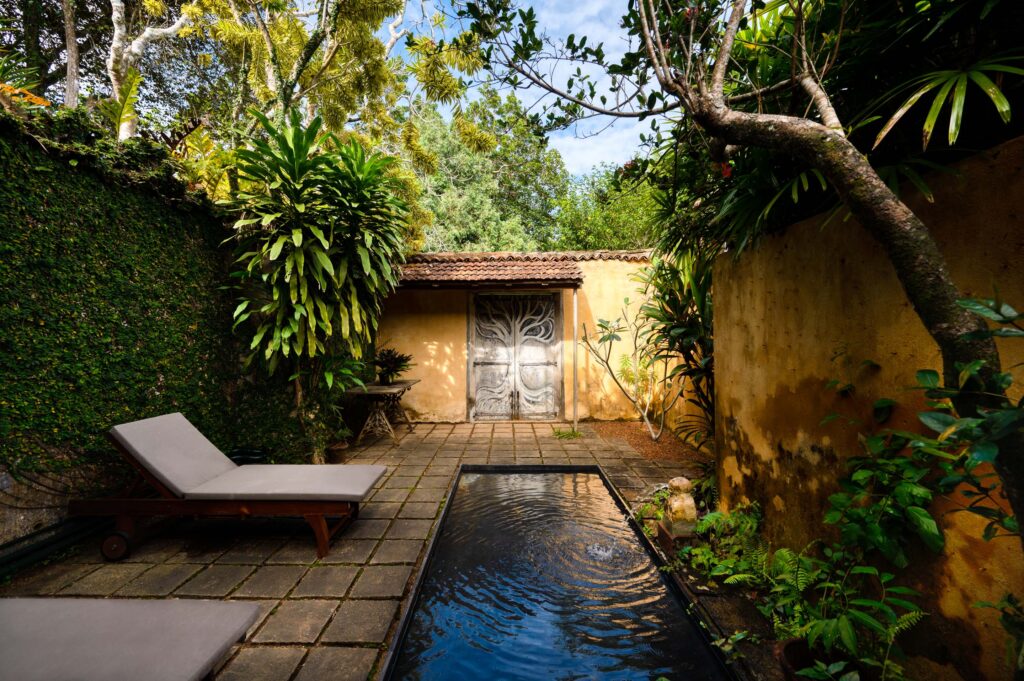
The Lush Country Estate of Master Architect Geoffrey Bawa is the Heart of a Dreamy, Well-drawn Hotel on the Far Side of the World
It is always a thrill to move inside a space once inhabited by a vaunted architect of a particular time. But when that architect is Geoffrey Bawa, both the flag-bearer and best-known proponent of Tropical Modernism, and the space is Lunuganga, his sumptuous Sri Lankan estate, that prospect is even more alluring, as a new wave of Southeast Asia travelers have discovered now that Geoffrey Bawa’s half-century obsession has been transformed into an exquisite and immersive hotel.
One of Asia’s most important and influential architects of the 20th century, Geoffrey Bawa is the rare figure to have experienced both colonial and post-independent Sri Lanka, and he purchased the property in 1948, the same year that the island nation was liberated from British rule. Most prolific in his native homeland, Bawa also designed buildings in India, Indonesia, Singapore and beyond, blending the clean lines of Le Corbusier with the local vernacular and natural surround.
Of the Geoffrey Bawa-built structures that survived the ravages of time and tropical weather, Lunuganga—an abandoned British rubber estate turned passionate pleasure garden lovingly cultivated over decades—is the most personal expression of Bawa himself. In its thick, unruly wilds, he saw its potential immediately.
“From the onset, Geoffrey Bawa was intent on finding a land with a connection to the water, and it took a considerable search to arrive at Lunuganga,” says the Geoffrey Bawa Trust.
But once he set his eyes on the land, which sits on the banks of the Dedduwa Lake, Bawa set his mind on transforming it.
As the architect wrote in a letter to a friend while working on his monograph Lunuganga: “It was enormously exciting, and the morning after the dramatic breaking of walls and the feel of possession, the adventure began.”
In truth, it never ended. From the moment the effort commenced to open the estate to its exalted view, Bawa continued to change and shape Lunuganga for 40 years, up until the last days of his practice. It was too idyllic a canvas for a man of vision to resist.
Located a few miles inland from Sri Lanka’s sublime west coast beaches, between the vibrant capital of Colombo and the historic old city of Galle, Lunuganga is a romantic and lavish Eden where Geoffrey Bawa’s Sri Lankan constructions—which are dripping in the adornments of the architect’s pan-cultural approach—are scattered throughout the estate’s mossy-green gardens of native trees, rice paddies, and water-lapped lily ponds interspersed with pathways, pavilions, gazebos, and Greek sculpture.
To understand the grounds is to understand the architecture itself, which Bawa designed to respond to the landscape via overhanging roofs and wide verandas connected to sublime outdoor courtyards flush with Southeast Asia exotica. Even when one is inside a structure, one is simultaneously out, if in sensation only. There is little barrier—physically or culturally—to the local environment.
Contained within independent structures that are strewn across the estate are nine individually furnished rooms and suites. Breezy and beautifully trimmed, these spaces are resplendent, featuring an easy yet elegant mix of batik textiles, antique and modern furnishings, and traditional and contemporary art.
Each space exudes an age-old beauty, but with its transom windows, private weathered ochre walls and gothic flourishes, the Gallery Studio is especially entrancing; originally built as a cowshed, the structure was eventually used as a gallery for Geoffrey Bawa’s art collection and stirs the imaginative sense.
For a glimpse into Geoffrey Bawa’s soul, the Geoffrey Bawa Suite—the architect’s personal quarters—was previously closed off to guests. Beautifully well kept, the suite is as lovely as a still life, if not a self-portrait of Bawa himself, containing a living area, an en-suite bath, adjoining plunge pool and charming outdoor courtyard as he enjoyed them.
But Lunuganga is the sum of more than one space—it is the whole of one man’s obsession, from its grand architecture to its lively and abundant gardens. Mossy and patinaed, with chipped paint, babbling fountains, grand entrances, and warm terracotta-tiled roofs, there is something of the ancient and mystical in this place. An Arcadia, once envisioned, then fully and lavishly realized by an architect that walked its grounds to the spellbinding tune of its whispers and wonders.
“The soothing qualities of the place prevail even today,” says the Geoffrey Bawa Trust. “It is both an ever-transient place and one where time stands still; a subtle change in the position of the sun or the direction of the wind will completely change the dance of the leaves at Lunuganga and its entire atmosphere. Yet it feels as though the gardens have always been there. We feel assured that it will remain.”
Lunuganga | teardrop-hotels.com/lunuganga
Photos: Teardrop Hotels